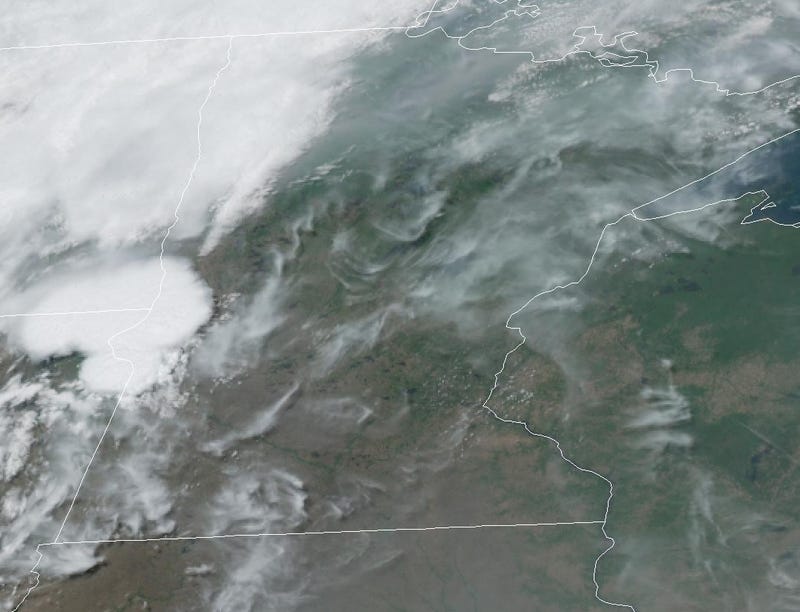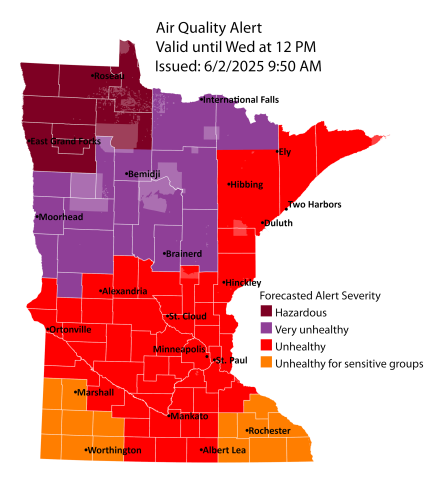
The Minnesota Pollution Control Agency has extended the air quality alert for all of the state with the northern part of the state seeing the worst of it.
Air quality is expected to reach the "Maroon" level, which will affect everyone - not just those who have pre-existing conditions. Maroon is the highest level concern that the MPCA Air Quality Index can reach. Right now, Fargo likely has the worst air quality in the world. Their AQI score of 297 is higher than traditionally poor AQI cities in Asia such as Islamabad, Hong Kong, and parts of India. Officials are warning those numbers in northwest Minnesota could jump over 300.
The MPCA says a band of very heavy ground-level smoke from Canadian wildfires has moved into northwest Minnesota behind a cold front, with fine particles in the air.
That's making it unhealthy and people are being encouraged to stay indoors.
The culprit, of course, is significant wildfires burning in Canada. More than 25,000 residents in three provinces have been evacuated as dozens of wildfires remained active and diminished air quality in parts of Canada and the U.S.
Officials initially thought the air quality would be improving by Monday evening, but now state forecasters say it's about to get worse, with much of the state including the Twin Cities in the "unhealthy for all" category beginning this evening.
Kathy Raleigh with the Minnesota Department of Health says many of us will definitely feel the impact on some level.
"Minor impacts such as irritation to your eyes, nose, throat, and lungs to make it hard to breathe and, causing symptoms such as cough and wheeze, wheezing," says Raleigh. "And then it also can range to very severe impacts, including, asthma attacks, heart attacks, and even stroke."
The MPCA says we're basically getting a one-two punch with both the Canadian wildfire smoke and ozone.
It's actually the first time ever that the northwest corner of the state is in the hazardous category for air quality.
"If you've not seen these colors before, this is the first time we have issued this maroon or hazardous air quality alert," says Matt Taraldsen who is a meteorologist with the Minnesota Pollution Control Agency. "This is only the second time we have issued a purple or very unhealthy air quality alert."
WCCO-TV Chief Meteorologist Chris Shaffer says again Monday, smoke will come in waves - that is now expected to continue through at least midweek now.
"The one constant has been that milky sky, the elevated smoke is always there, and at times it's mixing down to the surface and that's when we are having the issues with breathing and stuff like that," says Shaffer.
Rain is forecasted to move across a large portion of the state Monday night and Tuesday, but the National Weather Service is saying even that won't help conditions that much.
Conditions in the far northwestern part of Minnesota is much worse and the MPCA lists those as "Hazerdous" now.
"Fine particle levels are expected to reach the maroon air quality index (AQI) category, a level considered hazardous for everyone," says the MPCA. "This area includes East Grand Forks, Roseau, and the tribal nation of Red Lake. In the maroon area, everyone should avoid any outdoor activity and stay indoors."
It's also a dire situation in north central Minnesota which is now a "Purple" or "very unhealthy" level. This area includes Brainerd, Bemidji, Moorhead, International Falls, and the tribal nations of Mille Lacs, Leech Lake, and Red Lake. In the purple area, everyone should avoid prolonged or heavy exertion and stay indoors.
The only "Orange" areas in the state, unhealthy for sensitive groups, are in the extreme southwest and southeast corners of Minnesota.

AIR QUALITY ALERT REMAINS IN EFFECT UNTIL 9 AM WEDNESDAY
* WHAT...The Minnesota Pollution Control Agency has issued an Air Quality Alert for fine particles pollution and ground-level ozone. The Air Quality Index (AQI) is expected to reach the Red or Unhealthy category.
* WHERE...Central Minnesota.
* WHEN...Until 9 AM Wednesday.
* IMPACTS...Some members of the general public may experience health effects. Sensitive groups, such as people with lung disease (including asthma), heart disease, and children and older adults, may experience health effects.
* ADDITIONAL DETAILS...A band of very heavy ground-level smoke from Canadian wildfires has moved into northwest Minnesota Monday morning behind a cold front. This smoke will continue to follow behind the cold front as it moves southeast and the smoke will impact central Minnesota beginning on Monday afternoon. The smoke will reach southern Minnesota by Monday evening. In addition, ground-level ozone may reach the Orange AQI category for the Twin Cities. Precipitation is expected across central Minnesota Monday evening, but may not help improve air quality much. Smoke will begin to clear central Minnesota Wednesday morning and air quality will improve below the alert threshold.
